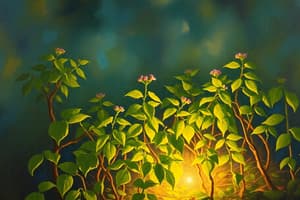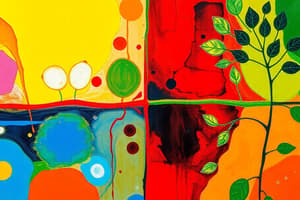Podcast
Questions and Answers
In photosynthesis, what is the primary role of light energy?
In photosynthesis, what is the primary role of light energy?
- To split carbon dioxide molecules to release oxygen.
- To directly convert carbon dioxide into sugar.
- To cool down the chloroplast, preventing damage from excessive heat.
- To excite electrons in water molecules, initiating the light reactions. (correct)
How do autotrophs obtain energy and carbon?
How do autotrophs obtain energy and carbon?
- By consuming other organisms.
- By converting light energy and inorganic compounds into organic matter. (correct)
- By absorbing nutrients from the soil.
- By directly absorbing organic molecules from the environment.
Which of the following statements accurately describes the relationship between wavelength and energy in photons?
Which of the following statements accurately describes the relationship between wavelength and energy in photons?
- Longer wavelengths contain more energy than shorter wavelengths.
- Shorter wavelengths contain less energy than longer wavelengths.
- Shorter wavelengths contain more energy than longer wavelengths. (correct)
- Wavelength is unrelated to the energy content of photons.
What is the main purpose of the Calvin cycle in photosynthesis?
What is the main purpose of the Calvin cycle in photosynthesis?
If a plant appears red, which wavelengths of light are most likely being reflected?
If a plant appears red, which wavelengths of light are most likely being reflected?
How do the light reactions and the Calvin cycle depend on each other in photosynthesis?
How do the light reactions and the Calvin cycle depend on each other in photosynthesis?
Which of the following is not an input of the photosynthesis process?
Which of the following is not an input of the photosynthesis process?
During photosynthesis, what is the initial source of electrons that are eventually transferred to the primary electron acceptor?
During photosynthesis, what is the initial source of electrons that are eventually transferred to the primary electron acceptor?
Where do the 'photo' and 'synthesis' (light-dependent and light-independent) reactions of photosynthesis occur within the chloroplast?
Where do the 'photo' and 'synthesis' (light-dependent and light-independent) reactions of photosynthesis occur within the chloroplast?
What is the primary purpose of the electron transport chain (ETC) in photosynthesis?
What is the primary purpose of the electron transport chain (ETC) in photosynthesis?
In the context of photosynthesis, what is the role of photons of light?
In the context of photosynthesis, what is the role of photons of light?
What directly captures light energy during the initial stages of photosynthesis?
What directly captures light energy during the initial stages of photosynthesis?
What is the immediate fate of the excited electrons after they are boosted to a higher energy level in the reaction center?
What is the immediate fate of the excited electrons after they are boosted to a higher energy level in the reaction center?
How does the fall of electrons down the electron transport chain contribute to ATP synthesis?
How does the fall of electrons down the electron transport chain contribute to ATP synthesis?
What is the ultimate destination of electrons from photosystem I?
What is the ultimate destination of electrons from photosystem I?
Where does the energy for ATP synthesis come from during the light-dependent reactions of photosynthesis?
Where does the energy for ATP synthesis come from during the light-dependent reactions of photosynthesis?
During the light reactions, what is the primary role of water (H2O)?
During the light reactions, what is the primary role of water (H2O)?
Which of the following statements accurately describes the flow of electrons during the light-dependent reactions of photosynthesis?
Which of the following statements accurately describes the flow of electrons during the light-dependent reactions of photosynthesis?
In the light reactions, how is the proton gradient established, and what is its primary function?
In the light reactions, how is the proton gradient established, and what is its primary function?
What is the role of ATP and NADPH in the Calvin cycle?
What is the role of ATP and NADPH in the Calvin cycle?
What is the function of the enzyme Rubisco in the Calvin cycle?
What is the function of the enzyme Rubisco in the Calvin cycle?
If a plant is exposed to a toxin that inhibits the regeneration of RuBP, what is the most likely direct consequence?
If a plant is exposed to a toxin that inhibits the regeneration of RuBP, what is the most likely direct consequence?
How many turns of the Calvin cycle are required to produce one molecule of glucose?
How many turns of the Calvin cycle are required to produce one molecule of glucose?
During the Calvin cycle, what happens to the majority of G3P (glyceraldehyde-3-phosphate) molecules that are produced?
During the Calvin cycle, what happens to the majority of G3P (glyceraldehyde-3-phosphate) molecules that are produced?
What is the primary role of Rubisco in the process of carbon fixation?
What is the primary role of Rubisco in the process of carbon fixation?
During the energizing the sugar stage, ATP transfers electrons to which molecule?
During the energizing the sugar stage, ATP transfers electrons to which molecule?
What happens to the majority of G3P molecules after they are produced in the Calvin cycle?
What happens to the majority of G3P molecules after they are produced in the Calvin cycle?
Which of the following is the correct number of ATP molecules that are required for the carbon fixation stage?
Which of the following is the correct number of ATP molecules that are required for the carbon fixation stage?
If a plant cell has a limited supply of ATP, which stage of the Calvin cycle would be most immediately affected?
If a plant cell has a limited supply of ATP, which stage of the Calvin cycle would be most immediately affected?
Considering the inputs and outputs of the Calvin cycle, what would likely happen if the enzyme Rubisco was inhibited?
Considering the inputs and outputs of the Calvin cycle, what would likely happen if the enzyme Rubisco was inhibited?
How many molecules of CO2 are initially 'fixed' to produce six molecules of 3-PGA?
How many molecules of CO2 are initially 'fixed' to produce six molecules of 3-PGA?
During the regeneration of RuBP in the Calvin cycle, what happens to the remaining five molecules of G3P after one molecule is used to produce glucose and other derivatives?
During the regeneration of RuBP in the Calvin cycle, what happens to the remaining five molecules of G3P after one molecule is used to produce glucose and other derivatives?
How do stomata contribute to balancing a plant's needs for photosynthesis and water conservation?
How do stomata contribute to balancing a plant's needs for photosynthesis and water conservation?
What is the primary challenge plants face when stomata are closed to conserve water, and how does this affect photosynthesis?
What is the primary challenge plants face when stomata are closed to conserve water, and how does this affect photosynthesis?
How do C4 plants minimize photorespiration compared to plants utilizing only the Calvin cycle?
How do C4 plants minimize photorespiration compared to plants utilizing only the Calvin cycle?
In C4 photosynthesis, what is the role of the mesophyll cells, and how does it facilitate the Calvin cycle in bundle-sheath cells?
In C4 photosynthesis, what is the role of the mesophyll cells, and how does it facilitate the Calvin cycle in bundle-sheath cells?
How does CAM photosynthesis temporally separate carbon fixation and the Calvin cycle, and why is this separation beneficial in desert environments?
How does CAM photosynthesis temporally separate carbon fixation and the Calvin cycle, and why is this separation beneficial in desert environments?
If a plant species is newly discovered in a very arid climate, and it only opens its stomata at night, which photosynthetic adaptation would you expect it to possess?
If a plant species is newly discovered in a very arid climate, and it only opens its stomata at night, which photosynthetic adaptation would you expect it to possess?
How does photorespiration counteract photosynthesis in plants, and why is it considered an inefficiency of the Calvin cycle under certain conditions?
How does photorespiration counteract photosynthesis in plants, and why is it considered an inefficiency of the Calvin cycle under certain conditions?
Flashcards
Photosynthesis
Photosynthesis
The process by which plants, protists, and bacteria convert light energy into chemical energy in the form of sugars.
Autotrophs
Autotrophs
Organisms that can produce their own food, like plants.
Photosynthesis Inputs
Photosynthesis Inputs
Sunlight, water (H2O), and carbon dioxide (CO2).
Photosynthesis Outputs
Photosynthesis Outputs
Signup and view all the flashcards
Light Reactions
Light Reactions
Signup and view all the flashcards
Calvin Cycle
Calvin Cycle
Signup and view all the flashcards
Chloroplasts
Chloroplasts
Signup and view all the flashcards
Plant Pigments
Plant Pigments
Signup and view all the flashcards
H2O Splitting
H2O Splitting
Signup and view all the flashcards
Photo Excitation
Photo Excitation
Signup and view all the flashcards
Thylakoid Location
Thylakoid Location
Signup and view all the flashcards
Primary Electron Acceptors
Primary Electron Acceptors
Signup and view all the flashcards
Photosystem
Photosystem
Signup and view all the flashcards
Photosystem II Role
Photosystem II Role
Signup and view all the flashcards
Proton Gradient
Proton Gradient
Signup and view all the flashcards
ATP Synthase Function
ATP Synthase Function
Signup and view all the flashcards
H2O Splitting in Light Reactions
H2O Splitting in Light Reactions
Signup and view all the flashcards
ETC 1 Function
ETC 1 Function
Signup and view all the flashcards
Photosystem II (PSII) and I (PSI) Primary acceptor
Photosystem II (PSII) and I (PSI) Primary acceptor
Signup and view all the flashcards
ETC 2 Function
ETC 2 Function
Signup and view all the flashcards
Calvin Cycle Main Function
Calvin Cycle Main Function
Signup and view all the flashcards
Rubisco
Rubisco
Signup and view all the flashcards
Role of ATP & NADPH
Role of ATP & NADPH
Signup and view all the flashcards
Calvin Cycle Turns for Glucose
Calvin Cycle Turns for Glucose
Signup and view all the flashcards
Carbon Fixation
Carbon Fixation
Signup and view all the flashcards
RuBP
RuBP
Signup and view all the flashcards
3-PGA
3-PGA
Signup and view all the flashcards
Energizing 3-PGA
Energizing 3-PGA
Signup and view all the flashcards
G3P
G3P
Signup and view all the flashcards
Glucose Production
Glucose Production
Signup and view all the flashcards
RuBP Regeneration
RuBP Regeneration
Signup and view all the flashcards
Stomata
Stomata
Signup and view all the flashcards
Most Plants (Photosynthesis)
Most Plants (Photosynthesis)
Signup and view all the flashcards
C4 Pathway
C4 Pathway
Signup and view all the flashcards
Photorespiration
Photorespiration
Signup and view all the flashcards
CAM Photosynthesis
CAM Photosynthesis
Signup and view all the flashcards
C4 Pathway
C4 Pathway
Signup and view all the flashcards
CAM Photosynthesis
CAM Photosynthesis
Signup and view all the flashcards
Study Notes
- Photosynthesis harnesses energy for life in two steps: "Photo" and "Synthesis".
Photosynthesis and Energy
- Organic matter serves as the primary food source.
- Autotrophs, like plants, produce their own food.
- Heterotrophs, like animals, obtain food from other sources.
Types of Photosynthesizers
- Plants such as sunflowers use photosynthesis.
- Protists also use photosynthesis.
- Bacteria use photosynthesis.
Inputs and Outputs
- The process requires three inputs: sunlight, H₂O, and CO₂
- The process yields two products: O₂ and sugar.
- During photosynthesis, carbon dioxide plus water yields glucose plus oxygen.
Phases of Photosynthesis
- "Photo" relates to the capture of light energy.
- "Synthesis" involves the synthesis of sugar using captured energy.
- H20, CO2, and light are all used to create Glucose
Stages of Photosynthesis
- The first stage involves light reactions.
- Water molecules are split, exciting electrons with photons.
- Electrons are then passed to energy carriers like NADPH & ATP.
- The energy from this stage is used in the second stage.
- The second stage is known as dark reactions, or the Calvin Cycle.
- Energy is used to fix CO2
- Carbohydrates (sugar) are produced
Chloroplasts
- The "photo" part occurs in thylakoids.
- The "synthesis" part occurs in the stroma.
Light Energy
- Light energy travels in waves and plant pigments absorb specific wavelengths.
- Kinetic energy occurs in energy packets that are called photons.
- Photons carry varying amounts of energy, carried as waves.
- Wavelength determines the amount of energy a photon contains.
- Shorter wavelengths have higher energy.
Electromagnetic Spectrum
- Visible light has wavelengths between 400nm and 740nm
- The electromagnetic spectrum organizes energy into waves of different lengths.
Chlorophyll
- Chlorophyll is a pigment located on the surface of thylakoid membranes.
Plant Pigments
- Plant pigments either absorb or reflect energy
- Chlorophyll a reflects green light.
- Chlorophyll b reflects yellow-green light.
- Carotenoids reflect yellow-orange and red light.
- Plants appear green because they reflect green light.
- Humans perceive only a range of energy as light, this is ROYGBIV.
- Pigments are molecules that absorb light
Light Reactions
- In light reactions, kinetic energy converts to chemical energy.
- The actions that occur are:
- Water is split to produce electrons, H+, and O2
- Electrons from H20 are transferred to a primary electron acceptor.
- Photons of light kick electrons up an orbital level, resulting in an excited state.
"Photo" Part
- This part involves Photosystem II, Electron Transport Chain 1, Photosystem I, and Electron Transport Chain 2
- This allows thylakoids to capture light energy.
- Reaction center molecules accept excited electrons from H₂O.
- Primary Electron Acceptors are where electrons are collected after being boosted.
- An Electron Transport Chain couples the transfer of electrons to a proton gradient.
- The proton gradient powers ATP synthesis (ATP Synthase), and the energy is transferred to NADPH.
- Protons rush out of thylakoid sacs, and the kinetic energy generates ATP molecules.
- In thylakoids, the capture of sunlight occurs by light-harvesting complexes and reaction centers.
Light Reactions Simplified (H₂O → H+ e- O₂)
- PII: split H2O into an e- acceptor, and releases H+ and O2.
- ETC 1: Electrons pump H+ inside, creating a gradient that generates ATP.
- PI: Electrons move to an acceptor.
- ETC 2: Electrons are used to produce NADPH.
"Synthesis" Part 2, Calvin Cycle
- This is where CO2 is used to synthesize Sugar
The Calvin Cycle (Stroma)
- The Calvin Cycle uses ATP & NADPH to synthesize sugar with enzymes.
- CO₂ + RuBP is joined by Rubisco, forming a 6-carbon sugar that splits into two 3-carbon sugars (3-PGA.)
- Rubisco makes 3-carbon sugar
- ATP + NADPH converts to high-energy G3P (used to produce glucose or other organic molecules.)
- Reduction: Make G3P and Sugar.
- Regenerate 5 G3P for glucose
Evolutionary Adaptations
- Plants adapt in hot or dry environments to reduce evaporative water loss
- Plant leaf pores, called stomata, open and close to allow CO₂ in and H₂O out
Stomata
- Stomata are leaf pores that open and close.
- When open, CO₂ can enter while H₂O exits.
- How can CO₂ be obtained when stomata are shut?
- Open Stomata: Water evaporates from the plant, releasing O2 and taking up CO2 to make sugar
- Closed Stomata: Stops water loss, no C for sugar, plant growth will stop, possibly death
Photosynthetic Pathways
- C3 Photosynthesis: Requires energy efficient and water is lost to evaporation in hot climates.
- C4 Photosynthesis: Water loss is minimized in warm climates, but requires more energy.
- CAM Photosynthesis: Water loss is minimized in hot climates, but requires more energy and there is slow growth.
- Most plants in temperate climates are C3 plants.
- "CO2-sticky tape” enzyme is in C4 Plants
- 'Nocturnal Plants' exhibit the CAM photosynthesis and have CO2 - holding molecule
- Maize, sorghum, sugar cane, and millet plants are able to maintain photosynthesis with a lower concentration of CO2
C4 Pathway
- In C4 plants, the enzyme rubisco frequently binds with O₂ rather than CO₂ resulting in photorespiration that undercuts photosynthesis.
- Many plants are C4 plants because they do less photorespiration and can better deal with drought conditions.
- The result is that C4 pathway enhances sustainability for photosynthesis under low carbon dioxide by grabbing CO2 and hold it.
CAM Photosynthesis
- Also called 'Nocturnal Plants'
- Plants' stomata open only at night and can only fix CO₂ at night.
- CO₂ is 'banked' until sunrise.
- During the day, light reactions power the Calvin cycle.
- Adaptable for desert plants (cacti).
Studying That Suits You
Use AI to generate personalized quizzes and flashcards to suit your learning preferences.




